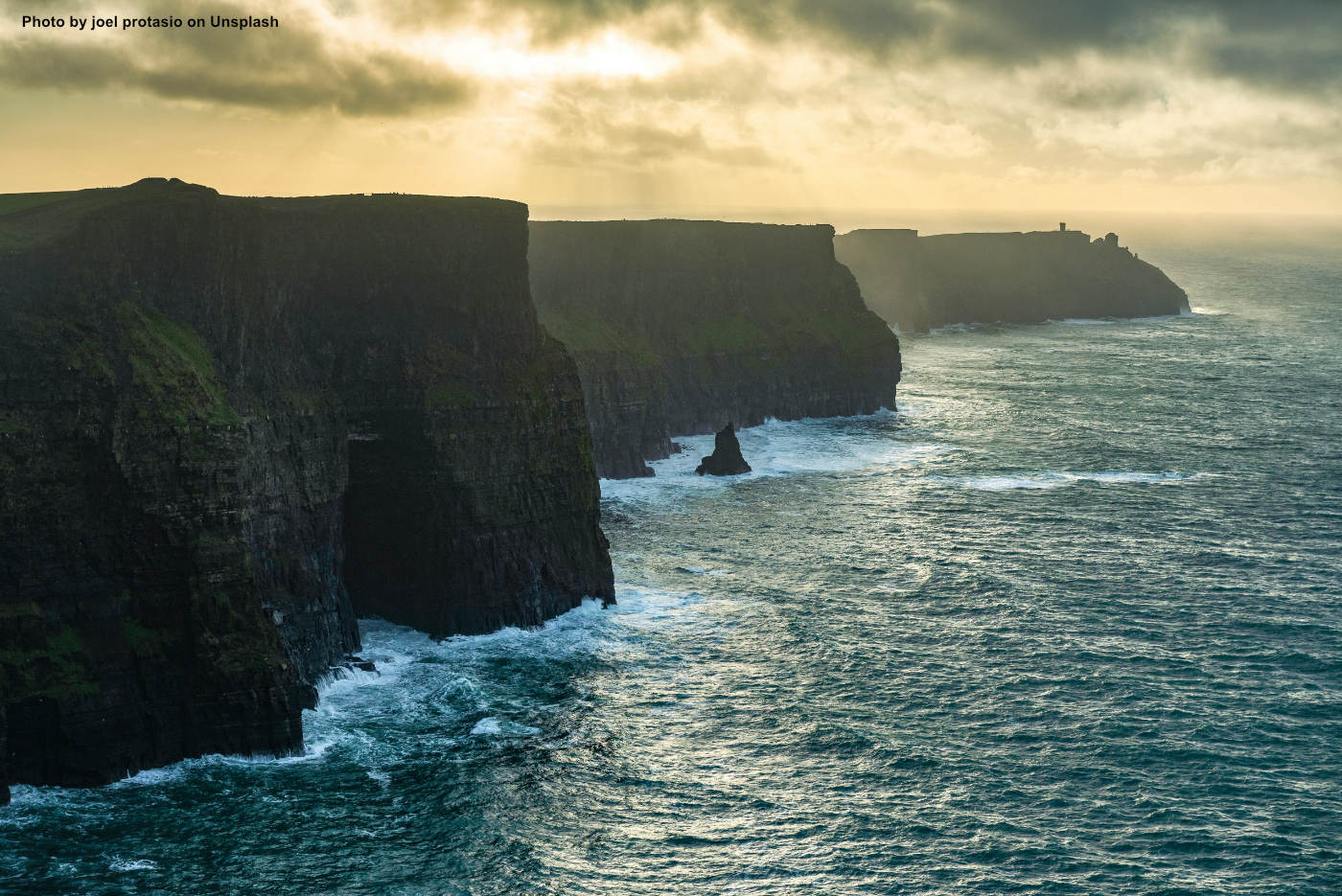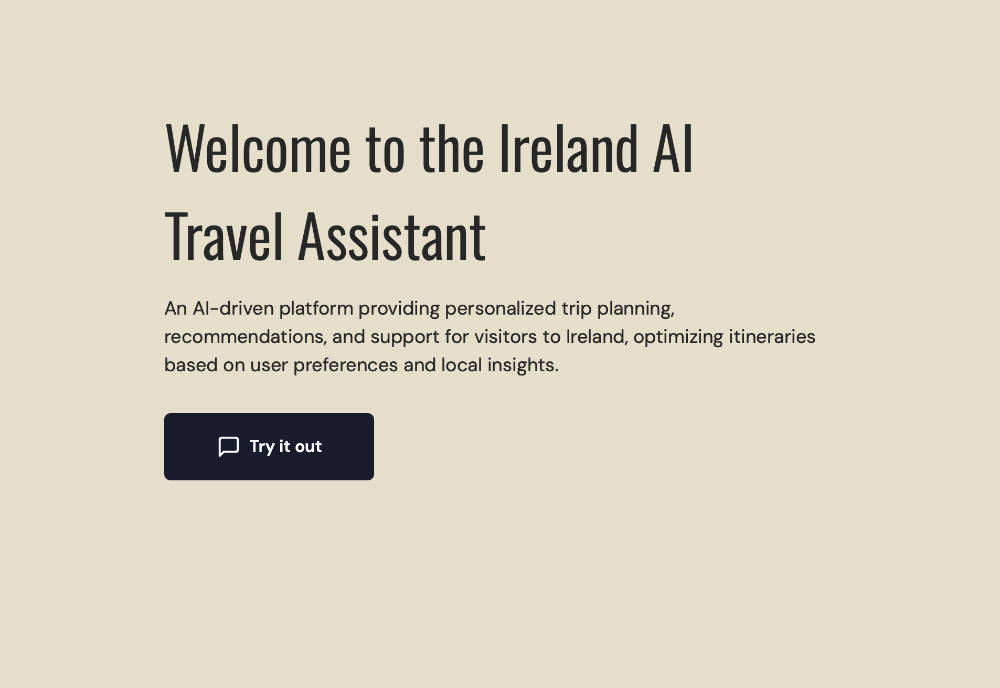Ireland Itinerary 7 Days Hub
Planning your Ireland itinerary 7 days? From stunning cliffs to historic castles, here’s how to create a week-long adventure you’ll never forget! On this Ireland Itinerary 7 Days Hub page we have some exciting 7 day itineraries which should definately get your brain planning a trip to Ireland.
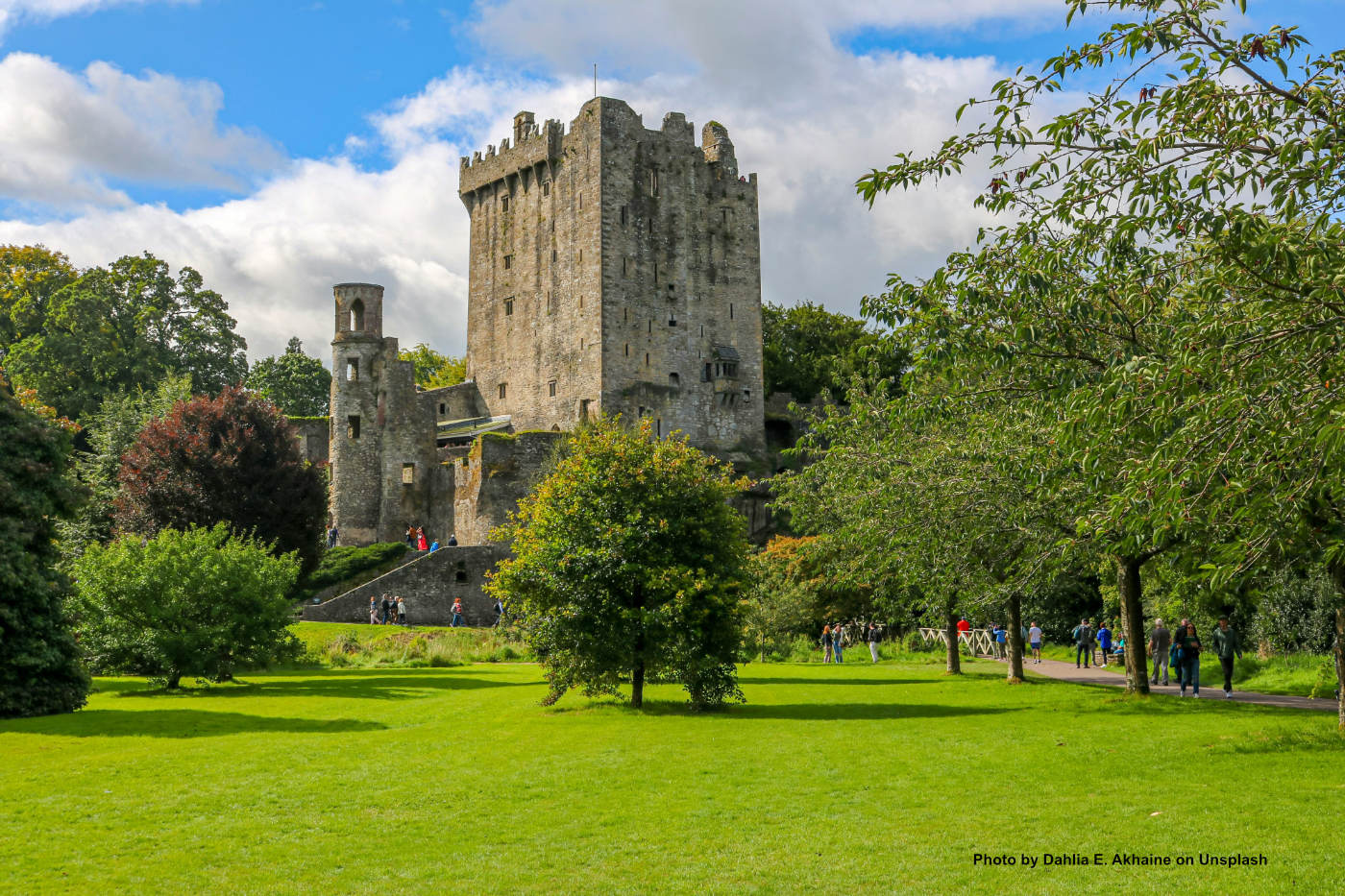
7 Day Ireland Itinerary from Dublin
Dreaming of Ireland? This Perfect 7 Day Ireland Itinerary from Dublin Will Have You Falling in Love with the Emerald Isle — One Adventure at a Time!
7 Days in Ireland
Begin your 7 days in Ireland in the vibrant city of Belfast, the gateway to stunning coastlines and rich history. From the Giant’s Causeway to Galway’s lively streets, every day promises unforgettable experiences!
Why Plan an Ireland Itinerary for 7 Days?
Planning a week-long adventure in Ireland? Our Ireland Itinerary Hub offers a variety of travel plans to suit your interests. For a detailed route starting from Dublin, check out our 7-Day Ireland Itinerary from Dublin, which provides a comprehensive guide to exploring the country’s highlights. These resources are designed to help you craft the perfect Irish journey.
A week in Ireland offers the perfect opportunity to experience the Emerald Isle’s highlights without feeling overwhelmed. With its compact size and rich diversity, Ireland is a destination where you can explore vibrant cities, dramatic coastlines, and quaint villages—all within a manageable timeframe. A well-planned Ireland itinerary of 7 days gives you enough time to soak in the culture, history, and natural beauty without rushing from one place to the next.
Whether you’re traveling solo, with family, or as part of a group, seven days strikes a balance between adventure and relaxation. It’s an ideal length for first-time visitors who want to experience Ireland’s famous landmarks, such as Dublin, Galway, and the Cliffs of Moher while leaving room for hidden gems like Dingle or the Burren. A week allows you to delve into Ireland’s charm while leaving you eager to return for more.
Why Seven Days is the Sweet Spot
Seven days hit the sweet spot for many travelers because it provides enough time to visit Ireland’s most iconic destinations without the stress of overpacking your schedule. It’s long enough to include multiple regions, such as the vibrant East Coast and the rugged West, while still giving you a chance to relax and take in the views. For those who want to strike a balance between urban exploration and countryside serenity, seven days is ideal.
Moreover, seven days allows for flexibility. You can spend a few days immersing yourself in history and culture, followed by scenic drives and nature hikes. It’s also a manageable timeframe for those on limited time off from work, making it the perfect choice for a getaway.
What Makes Ireland Perfect for a 7-Day Trip?
Ireland’s compact size makes it uniquely suited for a week-long itinerary. Unlike larger countries, where long travel times eat into your schedule, Ireland allows you to move between cities and natural attractions relatively quickly. For example, you can drive from Dublin to Galway in under three hours, with plenty of scenic stops along the way. This accessibility makes it easy to experience Ireland’s diverse offerings within a short timeframe.
The mix of vibrant urban centers, like Dublin and Cork, and peaceful rural retreats, such as the Aran Islands or Connemara, means you’ll have a well-rounded experience. Whether you’re interested in history, food, music, or nature, Ireland offers something for everyone—all packed into a compact, easy-to-navigate destination.
Setting Realistic Expectations
While seven days is enough to enjoy many of Ireland’s highlights, it’s important to set realistic expectations. You won’t be able to see everything in one trip, so it’s best to prioritize what excites you most. For example, if you’re passionate about history, focus on castles, monastic sites, and Dublin’s museums. If nature is your priority, spend your time along the Wild Atlantic Way or in Ireland’s national parks.
Trying to cover too much ground in a week can lead to travel fatigue. Instead of racing from one end of the country to the other, choose one or two regions to explore in depth. This approach allows you to savor the journey, connect with locals, and immerse yourself in Ireland’s magic without feeling rushed.
Who is This Length of Trip Best For?
A 7-day Ireland itinerary is perfect for a wide range of travelers. For couples, it offers the chance to combine romantic castle stays with scenic coastal drives. Families will appreciate the variety of activities that can keep kids engaged, from interactive museums to outdoor adventures. Solo travelers will find that a week provides enough time to meet new people while still enjoying moments of solitude in Ireland’s peaceful countryside.
This trip length also works well for travelers looking to balance cultural experiences with relaxation. You’ll have time to explore bustling cities like Dublin or Galway and still unwind in a quiet village or along a tranquil beach. Seven days is the sweet spot for travelers seeking diversity without overwhelming themselves with too many stops.
How This Guide Can Help You
This guide is designed to help you make the most of your 7-day Ireland itinerary. By offering high-level advice on planning, it serves as a roadmap to navigating Ireland’s must-visit destinations, hidden gems, and cultural experiences. The guide also links to more detailed itineraries for specific interests, such as history, nature, or food, allowing you to customize your trip to match your passions.
With practical tips on transportation, budgeting, and seasonal travel, this guide takes the guesswork out of planning. It’s your ultimate resource for crafting a trip that’s as enjoyable as it is efficient, ensuring you make the most of every moment in Ireland.
Key Considerations for a Ireland itinerary of 7 Days
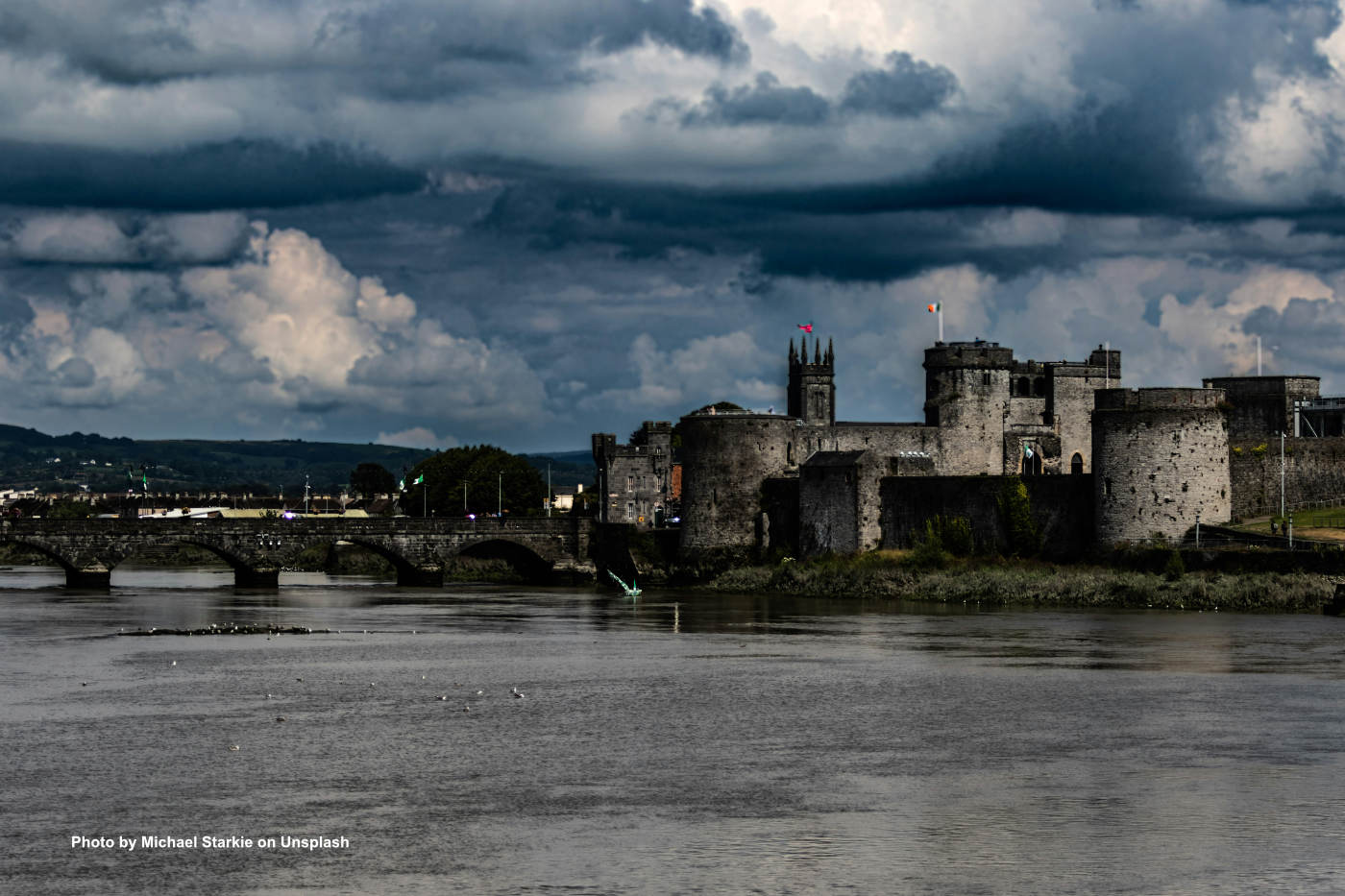
Planning a successful Ireland itinerary 7 days requires thoughtful preparation. By addressing factors like your travel style, the regions you want to explore, and how to manage your time, you can ensure your trip is seamless and stress-free. Below, we dive into the key considerations that will help you maximize your experience on the Emerald Isle.
Choosing Your Travel Style
How you choose to get around Ireland will shape your overall experience. Renting a car is a popular option, giving you the flexibility to explore remote areas, take scenic detours, and move at your own pace. It’s especially useful for accessing rural gems like Connemara or the Ring of Kerry. However, driving in Ireland comes with its quirks, such as navigating narrow, winding roads and driving on the left side. For those unfamiliar with manual cars, requesting an automatic in advance is crucial, as they’re less common in Ireland.
If you’d rather skip the stress of driving, public transport is a great alternative for urban-focused trips. Trains and buses connect major cities like Dublin, Galway, and Cork, as well as some key tourist attractions. Alternatively, guided tours offer the best of both worlds, combining convenience with local expertise. These tours often include transportation, insider knowledge, and access to unique experiences, making them ideal for travelers who prefer a structured approach.
Seasonal Travel Tips
The time of year you visit Ireland will significantly impact your trip. Spring and summer are the most popular seasons, offering longer daylight hours, blooming landscapes, and a lively atmosphere. Festivals like St. Patrick’s Day in March or the Galway Arts Festival in July add cultural excitement to your itinerary. However, these seasons also come with larger crowds and higher prices, so planning and booking accommodations early is essential.
Autumn provides a quieter alternative, with milder weather and stunning fall foliage in places like the Wicklow Mountains. Winter travel, while less common, has its own charm. The festive season brings Christmas markets, cozy pub evenings, and fewer tourists. However, shorter days and potential closures of attractions mean you’ll need to plan more carefully. Whatever season you choose, Ireland’s weather can be unpredictable, so packing layers and waterproof clothing is always a good idea.
Regional Focus
To make the most of a 7-day trip, it’s best to concentrate on one or two regions rather than trying to see the entire country. The east and south offer a mix of urban and historical highlights, with Dublin, Kilkenny, and Cork providing a blend of culture and heritage. This region is ideal for first-time visitors looking for an introduction to Ireland’s cities and historic sites.
If dramatic landscapes and coastal beauty are your priority, the West is a must. The Wild Atlantic Way, Cliffs of Moher, and Connemara showcase Ireland’s natural wonders. Meanwhile, Northern Ireland offers a different flavor, with highlights like Belfast’s Titanic Quarter and the Giant’s Causeway. Choosing a regional focus helps you avoid travel fatigue and ensures you can fully enjoy each destination.
Balancing Travel Times
While Ireland’s compact size makes it tempting to pack your itinerary, it’s important to balance travel times with exploration. Driving between major cities like Dublin and Galway takes just a few hours, but adding multiple stops can extend your journey significantly. For example, if you’re traveling along the Wild Atlantic Way, it’s easy to lose hours admiring the stunning views.
A good rule of thumb is to plan at most three to four hours of travel per day and focus on clustering nearby attractions. This approach not only gives you more time to enjoy each stop but also prevents the exhaustion that comes with long, back-to-back travel days. Instead of racing to cover all four provinces, stick to one or two for a deeper, more fulfilling experience.
Budgeting for Seven Days in Ireland
Understanding your budget ahead of time will help you make the most of your trip without unexpected surprises. Accommodations range from budget-friendly hostels and B&Bs to luxury castle stays, offering something for every traveler. Renting a car adds to your costs but can be offset by choosing affordable lodging or dining options. Public transport is generally less expensive, making it a great choice for budget-conscious travelers.
Dining in Ireland is another area where you can tailor costs. Pubs often serve hearty, affordable meals like Irish stew or fish and chips. At the same time, fine dining establishments in cities like Dublin and Galway cater to foodies willing to splurge. Don’t forget to factor in attraction fees, such as guided tours or heritage site entries. By planning and prioritizing expenses, you can enjoy a memorable trip without breaking the bank.
Themed 7-Day Itineraries to Explore
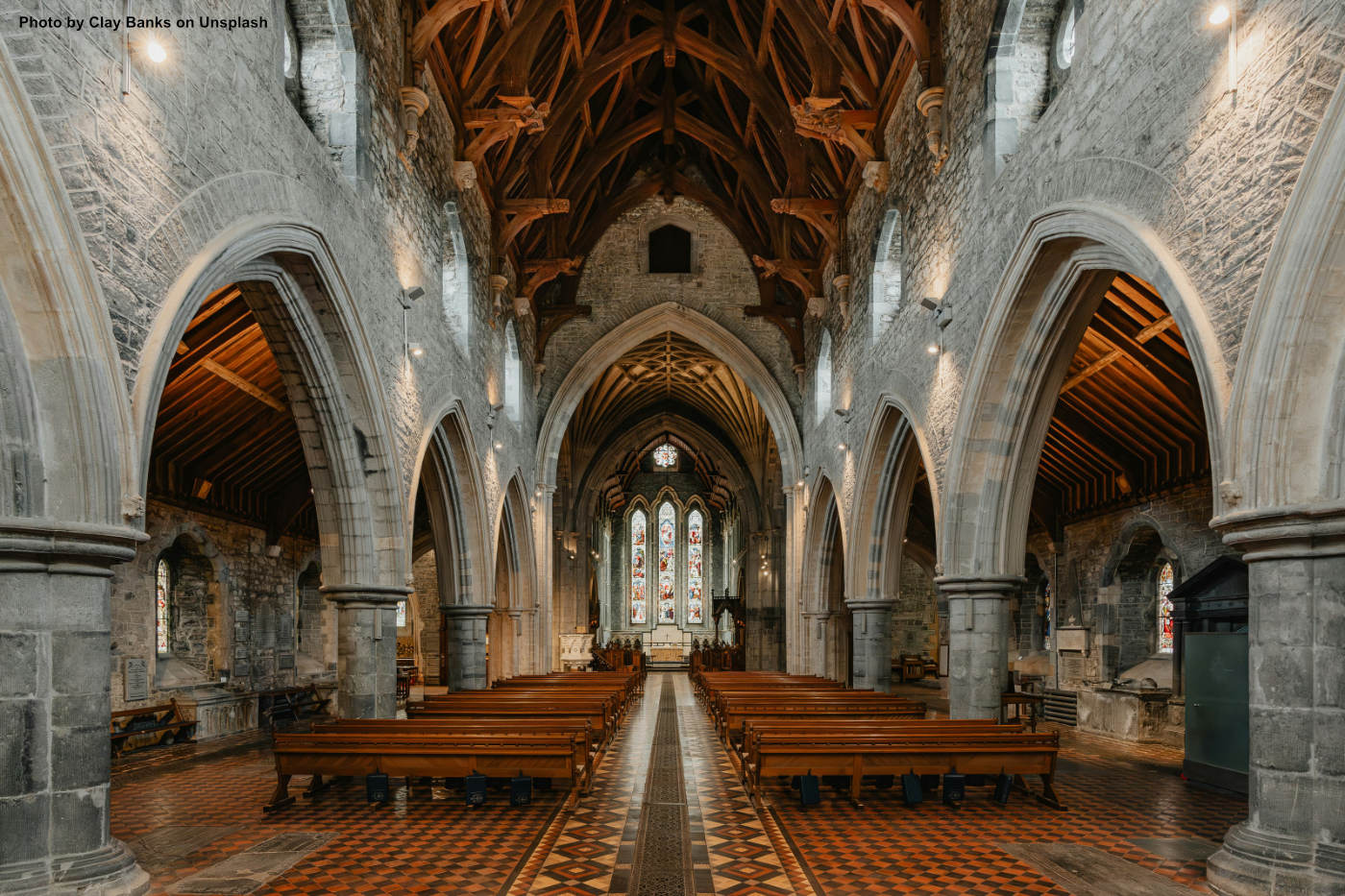
A 7-day Ireland itinerary can take many forms depending on your interests. By choosing a specific theme, you can ensure your trip aligns perfectly with what excites you most, whether it’s uncovering ancient history, immersing yourself in nature, or indulging in the country’s rich culinary and cultural offerings. Below, we outline a variety of themed itineraries, each linking to more detailed guides for deeper exploration.
History and Culture Focus
Ireland’s history stretches back thousands of years, making it a treasure trove for history lovers. A week dedicated to exploring its ancient sites and cultural landmarks offers a fascinating glimpse into the past. Begin your journey with a visit to Newgrange, a Neolithic tomb that predates the pyramids of Egypt. Its ingenious alignment with the winter solstice highlights the advanced knowledge of Ireland’s ancient peoples.
From there, head to Kilkenny Castle and the Rock of Cashel, both of which showcase Ireland’s medieval legacy. In Dublin, explore Trinity College to view the Book of Kells and the breathtaking Long Room library. Add a visit to Waterford, Ireland’s oldest city, where you can delve into Viking history at Reginald’s Tower. Finally, complement your itinerary with immersive cultural experiences like traditional storytelling evenings or visits to heritage villages, where history truly comes alive.
Nature Lover’s Escape
Ireland’s landscapes are as diverse as they are stunning, making the country a haven for nature enthusiasts. A week dedicated to outdoor adventures begins with the Cliffs of Moher, where you can walk cliffside trails with views of the Atlantic Ocean. The nearby Burren offers a stark contrast with its unique limestone terrain, home to rare plants and wildlife.
Further west, the unspoiled beauty of Connemara National Park provides opportunities for hiking and photography among rugged peaks and shimmering lakes. The Wild Atlantic Way is a must for scenic drives, featuring highlights like the Ring of Kerry and Achill Island. For a mix of nature and history, visit Glendalough in the Wicklow Mountains, where tranquil lakes and ancient monastic ruins create an unforgettable setting.
Food, Drink, and Music Trail
Ireland’s culinary and cultural scene has undergone a renaissance in recent years, making it a dream destination for foodies and music lovers. Start in Cork’s English Market, a haven for artisanal goods, fresh produce, and local treats. Seafood lovers should head west to Galway and Dingle, where fresh catches like oysters and crab are served in charming coastal restaurants.
No food-themed itinerary is complete without a whiskey or beer experience. Tour the Jameson Distillery in Dublin or Bushmills Distillery in Northern Ireland to learn about the craft of whiskey-making. For beer enthusiasts, a visit to the Guinness Storehouse is a must. Pair these experiences with evenings in traditional pubs, where live music brings Ireland’s lively culture to life. Towns like Doolin and Westport are particularly famous for their vibrant music scenes, offering a perfect mix of food, drink, and entertainment.
Family-Friendly Adventures
Ireland’s family-friendly charm ensures there’s something for everyone, from kids to grandparents. Start in Dublin with a visit to EPIC: The Irish Emigration Museum, which offers interactive exhibits that engage visitors of all ages. For outdoor fun, a trip to the Aran Islands provides opportunities for cycling and exploring ancient forts like Dún Aonghasa.
Kids will love the fairy-tale appeal of Blarney Castle, where they can kiss the famous stone and roam the expansive grounds. Sheepdog demonstrations on rural farms are another highlight, showcasing Ireland’s agricultural traditions in a way that’s both educational and entertaining. Don’t miss a jaunting car ride through Killarney National Park, where families can enjoy gentle trails, lakeside views, and opportunities for wildlife spotting.
Northern Ireland Highlights
Northern Ireland is brimming with unique attractions and stunning scenery, making it an excellent focus for a themed itinerary. Begin in Belfast, where the Titanic Quarter and its world-class Titanic Belfast museum explore the city’s maritime heritage. From there, visit the Giant’s Causeway, a UNESCO World Heritage Site known for its striking basalt columns and fascinating geology.
Thrill-seekers should head to the Carrick-a-Rede Rope Bridge, where breathtaking coastal views await. Fans of Game of Thrones will appreciate visiting filming locations like the Dark Hedges and Ballintoy Harbour. For a quieter experience, drive through the Sperrin Mountains, one of Northern Ireland’s most picturesque yet underappreciated regions, perfect for unwinding away from the crowds.
Practical Advice for a 7-Day Trip
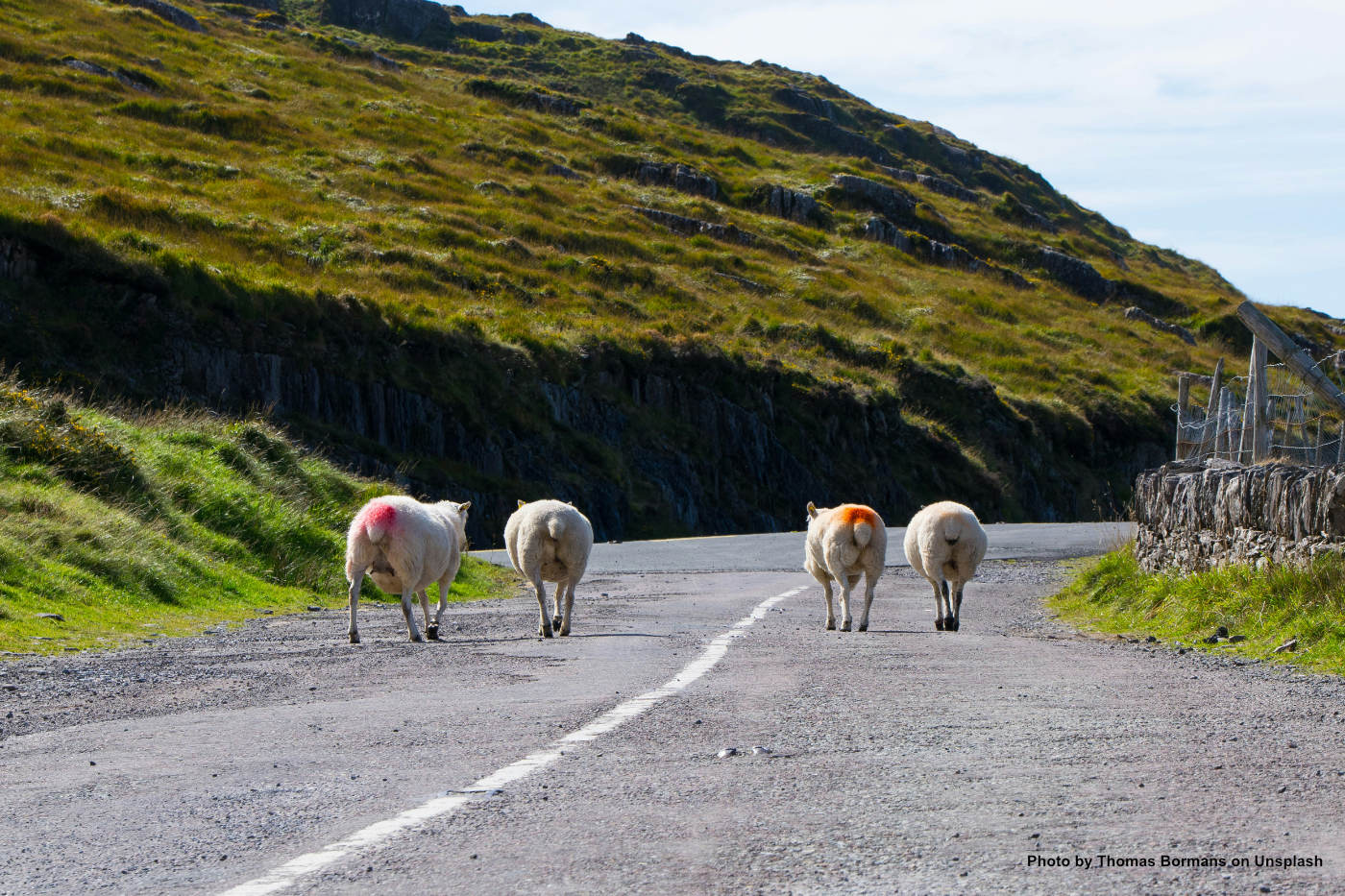
Proper planning ensures your week in Ireland runs smoothly, allowing you to focus on the beauty and experiences of the Emerald Isle. From selecting transportation to packing for unpredictable weather, this practical advice will help you maximize your time and enjoyment while minimizing stress.
Transport Options and Tips
Choosing how to travel around Ireland is one of the most important decisions when planning your itinerary. Renting a car is often the best option for those seeking flexibility. It allows you to access rural areas like Connemara, the Ring of Kerry, or the Burren, which are less easily reached by public transport. However, be prepared for challenges like driving on the left side of the road and navigating narrow country lanes. Renting an automatic car is advisable for those unfamiliar with manual transmissions. Still, it’s wise to book early since automatics are less common in Ireland.
Public transport offers a budget-friendly and stress-free way to explore major cities and popular sites. Trains and buses connect Dublin, Galway, Cork, and Belfast, making them ideal for urban-focused trips. For a mix of convenience and cultural immersion, guided tours often include transportation, detailed itineraries, and insider knowledge from local guides. These tours are especially helpful for first-time visitors or those wanting to visit areas like the Cliffs of Moher without the hassle of self-driving.
Packing for One Week in Ireland
Ireland’s weather is famously unpredictable, so packing appropriately is essential. Start with layers, including lightweight t-shirts, sweaters, and a waterproof jacket. These versatile items let you adapt to shifting conditions, whether it’s a brisk morning in Dublin or a windy walk along the Cliffs of Moher. A sturdy pair of walking shoes is a must for exploring cobblestone streets, castle grounds, or hiking trails in national parks.
Your daypack should include essentials like a refillable water bottle, sunscreen, and a compact umbrella or poncho. Even in summer, unexpected rain showers are common, so having waterproof gear on hand ensures your plans aren’t derailed. Packing light is advisable, especially if you’re moving between accommodations frequently, as it makes travel more convenient and hassle-free.
Choosing Accommodations
Where you stay can significantly shape your experience in Ireland. For those who want to be in the heart of the action, city-center hotels in Dublin, Galway, or Cork offer convenience and easy access to attractions. Rural B&Bs provide a more intimate and authentic experience, often run by friendly locals eager to share tips about hidden gems in their area.
For a truly unique stay, consider splurging on a night in a castle hotel. Properties like Ashford Castle or Ballynahinch Castle combine luxury with Ireland’s rich history, offering an unforgettable experience. Alternatively, self-catering cottages are perfect for families or groups, providing privacy and the flexibility to prepare your own meals. Booking in advance is essential, especially during peak travel seasons when the best accommodations fill up quickly.
Maximizing Your Time
Time management is key to making the most of a 7-day itinerary. Start your days early, as many attractions can get crowded later in the day. For example, visiting the Cliffs of Moher or Dublin’s Trinity College in the morning lets you enjoy these iconic sites with fewer people around. Grouping nearby attractions, like the Burren and the Cliffs of Moher, minimizes travel time and maximizes sightseeing opportunities.
Allow room in your schedule for downtime. Ireland’s charm often lies in the unexpected—whether it’s a spontaneous stop at a local café, a quiet stroll through a village, or an impromptu conversation with a local. Building rest periods into your itinerary ensures you stay refreshed and open to the surprises that make travel magical.
Cultural Tips for Travelers
Immersing yourself in Ireland’s culture is one of the highlights of any trip. Pub etiquette is an important aspect to understand—unlike in some countries, you’ll order your drinks at the bar rather than from your seat. Striking up conversations with locals in pubs is common and can lead to memorable stories or recommendations for hidden gems.
When dining or taking tours, tipping is appreciated but optional. A 10–15% tip for good service in restaurants is standard. While English is spoken throughout Ireland, learning a few Irish phrases like “céad míle fáilte” (a hundred thousand welcomes) or “sláinte” (cheers) can add a fun, personal touch to your interactions with locals. Being respectful of historical or sacred sites, such as abbeys or ancient ruins, ensures you contribute to preserving Ireland’s heritage for future visitors.
Considerations for a 7-Day Ireland Itinerary

Even with a well-planned itinerary, it’s natural to have questions when preparing for a week-long trip to Ireland. From figuring out the ideal travel duration to managing unpredictable weather, here are answers to some of the most common concerns travelers have about planning their journey.
Is seven days enough to experience Ireland?
Seven days is an excellent amount of time to experience Ireland’s highlights, but it’s important to set realistic expectations. You won’t see everything, and that’s okay. Instead of trying to cover the entire country, focus on one or two regions to enjoy a more in-depth experience. For example, you could explore Dublin, Galway, and the Wild Atlantic Way or concentrate on Northern Ireland and Donegal.
The key is to prioritize quality over quantity. By immersing yourself in a smaller selection of destinations, you’ll have time to enjoy iconic landmarks, connect with locals, and embrace the slower pace that makes Ireland so enchanting. Seven days gives you enough flexibility to see world-famous attractions while still leaving time for spontaneous adventures, like stumbling upon a local festival or discovering a hidden beach.
Should I stick to one region or explore multiple?
If you prefer a relaxed pace, sticking to one region allows you to explore it thoroughly without feeling rushed. For example, focusing on the west coast lets you experience Galway’s vibrant culture, the Cliffs of Moher’s breathtaking views, and Connemara’s rugged beauty—all within a manageable travel distance. Similarly, the east and south regions offer a mix of historical landmarks like Kilkenny Castle and Glendalough, combined with urban experiences in Dublin.
For those comfortable with a bit more travel, visiting two regions—like Dublin and the west or Northern Ireland and Donegal—is feasible. The key is to minimize long travel days and cluster nearby attractions. For instance, pairing the Burren with the Cliffs of Moher works well, as does combining Belfast with the Giant’s Causeway. With careful planning, exploring multiple regions in seven days can be rewarding without becoming overwhelming.
Do I need a car for a 7-day trip?
Whether or not you need a car depends on your itinerary and travel style. A rental car is ideal for those venturing into rural areas, such as the Wild Atlantic Way or the Ring of Kerry, where public transport options are limited. Having a car also gives you the freedom to take scenic detours and explore hidden gems off the beaten path. Just be prepared for driving on the left side and navigating narrow country roads.
If your focus is on cities like Dublin, Galway, or Belfast, a car isn’t necessary. Ireland’s public transport system—trains and buses—connects major hubs and popular attractions. Guided tours are another great option for reaching sites like the Cliffs of Moher or Giant’s Causeway without worrying about driving. For travelers who want a mix of urban exploration and rural adventures, renting a car for part of the trip and relying on public transport for the rest can be a good compromise.
What’s the average budget for a week-long trip?
The cost of a 7-day Ireland itinerary varies depending on your travel style. Budget travelers can expect to spend around $1,500 per person. In comparison, those opting for mid-range or luxury experiences may spend closer to $2,500 or more. Key expenses include accommodations, transportation, food, and activities.
Accommodations range from affordable hostels and B&Bs to luxurious castle stays, so there’s an option for every budget. Dining also varies widely—hearty pub meals are cost-effective. In contrast, fine dining in cities like Dublin or Galway can be a splurge. Transportation costs depend on whether you rent a car or use public transport, and attraction fees (such as guided tours or entrance to heritage sites) should be factored in as well. Planning and budgeting ahead will help you enjoy your trip without financial surprises.
How do I handle unpredictable weather?
Ireland’s weather is famously changeable, but embracing its unpredictability is part of the charm. Packing smartly is your first line of defense—layered clothing, a waterproof jacket, and sturdy shoes will keep you comfortable no matter what. A compact umbrella or poncho is also a must, as rain showers can appear out of nowhere, even on sunny days.
Plan outdoor activities like hikes or cliffside visits in the morning when the weather tends to be clearer. Have a backup plan for rainy days, such as exploring museums, castles, or cozy pubs. Embracing Ireland’s weather means seeing the beauty in every moment. Whether it’s mist rolling over the hills or a dramatic storm over the ocean, it all adds to the magic of the Emerald Isle.
What’s the best way to avoid feeling rushed?
To avoid travel fatigue, keep your itinerary focused and realistic. Plan up to two or three destinations for the week, allowing enough time to explore each one fully. For example, instead of trying to visit both Northern Ireland and the west coast, pick one and enjoy it thoroughly.
Incorporate downtime into your schedule, such as leisurely lunches at a local café or an afternoon stroll in a quiet village. Early starts can help you avoid crowds at popular attractions, leaving the rest of your day for more relaxed activities. By prioritizing quality over quantity, you’ll create a richer and more enjoyable experience.
A 7-day Ireland itinerary offers the perfect balance of adventure, culture, and relaxation, giving you just enough time to savor the highlights of the Emerald Isle while leaving you wanting more. Whether you’re exploring Dublin’s historic streets, standing in awe of the Cliffs of Moher, or enjoying a lively pub session in Galway, every moment in Ireland feels like stepping into a storybook. By focusing on one or two regions and tailoring your trip to your interests, you can create an itinerary that’s both enriching and memorable.
The key to a successful trip lies in preparation and balance. Set realistic expectations, embrace the country’s natural pace, and allow yourself the freedom to linger when something captures your heart. With practical considerations like packing layers, choosing the right mode of transport, and budgeting wisely, you’ll be well-equipped to navigate Ireland’s charm and quirks. A little flexibility goes a long way, especially when the unpredictable weather or an impromptu discovery adds unexpected magic to your journey.
Seven days may seem brief, but the memories you’ll make in that time will stay with you for years to come. Ireland isn’t just a destination; it’s an experience—one filled with heartfelt connections, breathtaking scenery, and a sense of timeless wonder. Whether you’re traveling for the first time or the tenth, Ireland’s beauty and warmth have a way of leaving a lasting impression.
So go ahead, start planning your 7-day itinerary, and prepare for an unforgettable adventure. Ireland is waiting to welcome you with open arms, a thousand tales to share, and landscapes that will take your breath away. Sláinte!
How to plan: Ireland Itinerary 7 Days with AI
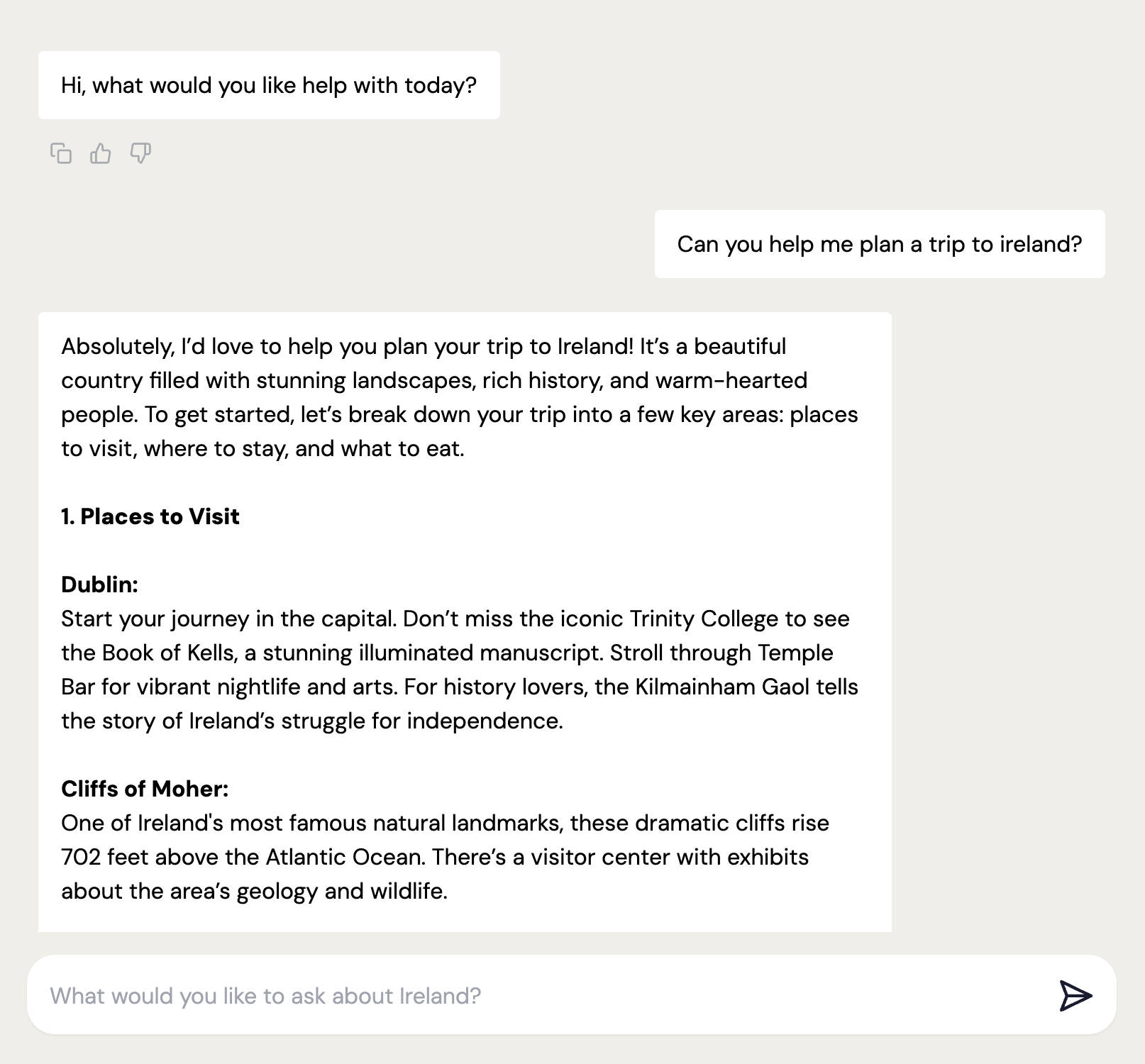
ASK THE AI TRAVEL EXPERT A QUESTION
Now that you are on the prompt screen, go ahead and ask the AI Ireland Travel Expert a question about Ireland that you need help with. Example: 'Plan for me: Ireland Itinerary 7 Days'.

RINSE & REPEAT
Now go ahead and ask the Expert any further questions or refine the answers you've been given. Next step: Travel to Ireland!

Did you know this article was created with the AI Ireland Travel Expert?
Planning an Ireland itinerary 7 days can feel like a juggling act. With so many incredible sights to see and experiences to enjoy, narrowing down your options can be overwhelming. That’s where the Ireland AI Travel Expert comes in. Acting as your personal digital assistant, the Expert simplifies the planning process by creating a tailored itinerary based on your preferences. Whether you’re keen on exploring historic landmarks, breathtaking landscapes, or lively cultural hubs, the Expert can design a trip that perfectly aligns with your vision.
One of the standout features of the Expert is its ability to streamline research and eliminate guesswork. Instead of spending hours browsing guidebooks or scouring the internet, you can input your interests, travel dates, and budget. The Expert will generate a detailed plan, recommending key attractions, routes, and activities that fit your profile.
For example, if you love nature, the Expert might suggest hiking in Connemara National Park, driving along the Wild Atlantic Way, or exploring the Cliffs of Moher. It ensures you maximize your 7 days without unnecessary detours or missed opportunities.
Flexibility is another strength of the Ireland AI Travel Expert. Plans change—maybe you decide to spend an extra day in Galway or squeeze in a visit to Northern Ireland. The Expert can instantly adapt your itinerary, recalculating travel times, nearby attractions, and even factoring in up-to-date weather conditions. This dynamic approach ensures your trip remains seamless, even when the unexpected arises. Ireland’s ever-changing weather or a chance encounter with a hidden gem won’t disrupt your carefully laid plans, thanks to the Expert’s quick adjustments.
Beyond crafting your itinerary, the Expert offers practical advice to enhance your travel experience. It can suggest what to pack for Ireland’s unpredictable weather, highlight local customs to make interactions smoother, and provide budgeting tips to ensure your trip stays on track financially.
With the Ireland AI Travel Expert by your side, you’ll have all the tools you need to create a personalized, stress-free adventure that makes the most of your Ireland itinerary 7 days.
FAQ
>> Is seven days enough to explore Ireland?
Seven days is enough to experience Ireland’s major highlights, but it’s best to focus on one or two regions to avoid feeling rushed.
>> Should I rent a car for a 7-day Ireland itinerary?
A car is ideal for exploring rural areas and scenic routes like the Wild Atlantic Way. For city-focused trips, public transport works well.
>> What’s the best time of year to visit Ireland for seven days?
Spring and summer offer longer days and festivals, while autumn provides fewer crowds. Winter has festive charm but shorter daylight hours.
>> How do I balance travel times during a 7-day trip?
Plan no more than three to four hours of travel per day, and group nearby attractions to make the most of your time.
>> Can I include Northern Ireland in a 7-day trip?
Yes, combining Northern Ireland with Dublin or the west coast is possible, but focus on fewer stops to avoid travel fatigue.
>> What’s a typical budget for a 7-day Ireland itinerary?
Budget travelers can expect to spend around $1,500 per person, while mid-range trips may cost $2,500 or more, depending on accommodations and activities.

